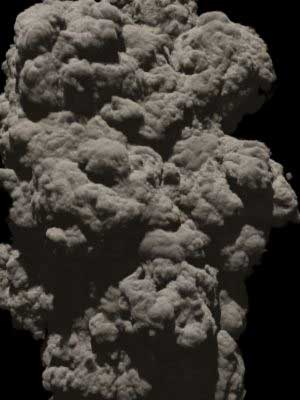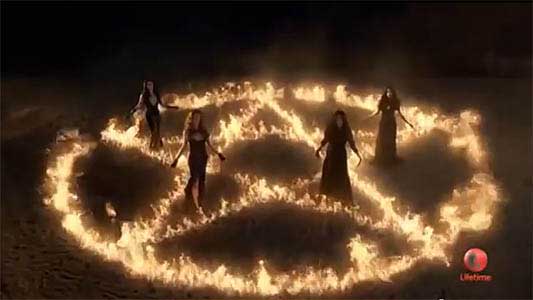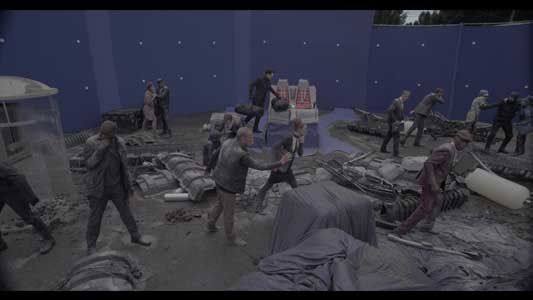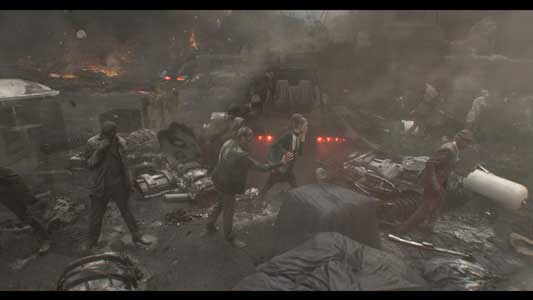


We would like to know how you got into the CG and what have pushed you into the visual special effects field?
I started out in 3D nearly 20 years ago in the mid 90's, so quite a while ago now! To be honest, I think that's what drove me to FX, is a combination of loving the curiosity of problem solving and finding solutions to difficult areas (and FX definitely is an area that involves a lot of this!) as well as the limitations of 3D back in the day! I was OBSESSED with trying to make clouds, fire, explosions, moreso because these things you couldn't model, you couldn't create in any way, they were the type of thing you would rely on photos or stock footage for whenever they were needed in a shot. So to me it became a huge drive to try to find ways to do this sort of thing. How the heck do you make clouds, when all you had back then is polygons?
In the early days of the VFX industry, it must have been quite different than it is nowadays. What were the biggest changes in the industry and how do you see it in the future?
As I mentioned, the tools back in the 90's were pretty limited. Maya's hardware renderer was able to spit out fairly decent sprite counts on particle systems, but that was the only real way to get any decent looking effects back then. And even so they weren't often with decent motion blur, if you knew your stuff you could do some pretty advanced things with sprites based on angular falloffs and additional additive maps and per-particle attribute dependent opacity shaders.
I was doing a lot of FX in 3D Studio DOS and early Max releases, Soft|Image and Maya when it came out. However there wasn't really that much you could do at the time outside of sprites and rendering tri's and other geo.
Maya had Digital Nature Tools which at the time was leading the way in doing more advanced FX. However it was quite sub-par. Soft|Image did some cool particle tricks but fell short on having any decent rendering solutions (for FX that is).
I remember the first videos that ever surfaced of AfterBurn showing thick self shadowing volumetrics, and clouds etc. and I remember thinking to myself "that is it!" I had found the tool I could use to do what I wanted! The biggest changes are definitely technology. This applies to all areas. Whether you're dealing with lighting, shaders, particles, even the way you model especially with surfacing, and interacting with models. Even today I (finally) discovered Substance Painter, which is a pretty unique way to paint and age surfaces, creative tools like this that come completely out of left field are what I always find exciting! I think with everything moving to internet cloud services, not only for rendering, but also 3D operating, it's becoming pretty amazing. I completed a couple of feature films this year from my macbook pro laptop from a hotel in Australia while on vacation (if you can call it that, I was working after all) via the internet VPN into my office in Santa Monica, California - having my simulations cook in LA, render on my farm with Backburner and automatically sending rendered quick times of passes back to laptop via dropbox. What you can do with Maxscript and some of the online services these days, you can easily become a one man army on most productions.
I actually plan to release a LOT of these types of tools throughout December/January which I'm pretty excited to see what people do with them!

AfterBurn smoke stack
Could you please name a few projects you were involved with and which one was the most challenging?
To be honest, it's hard to have a favorite. I think the ones you bled for the most are the ones you hold the closest to your heart. I think working on Priest was a challenge initially, because I was brought on to come up with a pipeline for doing a massive sequence of explosions back when that wasn't all too common, and find ways to have those break away from what was at the time fairly obviously simulated. I had a blast (no pun intended) on that project and I got to work with some really great friends, Mike Janov, Ansi Seherr-Thoss and many others. Working with the guys at Atomic Fiction has been a bit of a game changer, I don't know why but I have a bit of a crush on that studio. The owners Ryan and Kevin are just revolutionists in what they do, I've been so used to fighting every battle on my own, being the guy to have to come up with every solution. And in a way that's been the first studio in a long time that I really felt like I could let go and seek guidance from those guys, they're so inspiring - and when I look at what are some of my favorite films, most of them are all from that studio! Transformers 3 was definitely a challenge and I developed many new ways of working on that project. Building tools that would construct max files from scratch and FumeFX simulations from that. Being faced with creating some very heavy explosion driven FX shots for that film, to be put under the microscope by the master of explosions himself - Michael Bay - was definitely a pretty demanding task. Whereas the same on the movie 'Flight' trying to crash a massive airliner into the ground, in the most pivotal scene in a movie ABOUT this crash, when there's really not meant to be any visual effects, and the entire thing is pretty much all CG. Is again so demanding. That's definitely a project that was A) How the heck do we do it? And then B) doing it and then C) oh crap, how the heck is this going to render?!
This year's been a challenging year, I did a lot of cool stuff for Metallica's new movie Into the Never, which I will be releasing a video shortly talking about hardware, studio set up and workflow and other ways to integrate FumeFX. Because on that project I had to do a lot of radical things to see the light of day on that one!
I also worked on the teaser at Comicon for the new Warcraft movie! Which was pretty exciting! There was very stylized fluid sims required and that was a time where I was given reference images of stuff very specifically made in photoshop that is unlike anything in the real world and told to match the looks of it exactly, which FumeFX definitely gave me that control to be able to do.
One of the recent works you did was the movie “Transformers 3” . Which shots you were responsible for and what Sitni Sati tools you were using?
Transformers 3 - I used a combination of FumeFX and Krakatoa along with Max's built in particle system Particle Flow. I had to develop a lot of large scale explosive shots, buildings being blown up, people in large numbers being evaporated. My studios client was Digital Domain, and their client was Michael Bay. This project was a massive undertaking with only a few weeks to turn around quite a handful of shots.

Transformers 3
I developed a lot of tools on this project to help with the process. Things I never even thought I could do, until I actually did them. In the end I would use information about the shots, such as characters names for each person in a particular shot, the frame numbers they were to die, as well as specific rigs I had developed. And then I would run a pretty intense maxscript I wrote, that would then go in and construct 128 max files, mainly all FumeFX scenes, from scratch. Which then would be submitted to the farm for simulating and then parsed through Krakatoa and resubmitted to the farm for rendering. 100% automated. I hadn't ever done something like this before, and it was the only way we could turn out the shots. I was still in denial when it actually worked, but it put me on a new path for doing visual effects which has played a big role in how I do things these days. Photo real fire, explosions, everything I did was through FumeFX.

Transformers 3
Also recently, God of War, which was a Super Bowl commercial - Karin Fong Directed it, alongside Jeremy Cox art directing, and Jon Hassel produced it for Imaginary Forces. I was VFX Supervisor and I took on most of the visual effects, everything to do with ash and Kratos world turning to ash around him. This is probably my favorite project and at the time I paid for it physically. It was ambitious and challenging, and it was only myself and another artist Desiree Lunsford handling the entire thing. I used FumeFX in ways that I hadn't ever before, such as all the initial breakups of rigid body sims of things breaking into ash, although driven through particles and rigid body sims, would initially activate and disturb through FumeFX fluids advecting them. This meant rather than the standard hard collapsing feel that happens with RBD's, everything would break elegantly and transition into dynamics. And naturally everything had a lot of additional dust and motion coming from FumeFX. It turned out beautifully, and it was viewed at the Super Bowl, which doesn't get much better than that!
What are some of your more recent projects you've worked on this year?
Actually, one other project, or two I did recently which were so bad ass! One was the promo for Witches of East End which showed at theaters allover America. It was a promo for a tv series that involved these witches performing magic and slowly walking around with fire trailing after them, the challenge was all of this had to be photo real and close up. I was asked to be on set for the shoot in Vancouver at the time, but had to travel to Australia. I ended up working on this project almost solely from my laptop. It was really amazing, I was juggling over 15 heavy duty FX shots with sometimes up to 60 (yes, SIXTY) FumeFX containers in each shot! I have written some production tools this year that have completely changed how I work. And I was able to turn out photo real fire for each of these shots and flexibly be able to say YES to every change or request asked, if they wanted variations on shots, whatever they needed. With FumeFX and some custom tools that I developed it suddenly became more about what they wanted than what we could accomplish. There was never an ounce of stress even though the project was so demanding.

Lifetime's Witches of East End - "Come As You Are" promo
Meanwhile, I was also working on another project called F-Light. For two directors in New York that I have known for over a decade. This project required 17 FX shots that were all roughly 15-20 containers per shot. I had created some tools on this project which literally meant I just get the initial camera and object tracking data and hit go, and watch it construct all of my shots for me from scratch including all of the FX, and have it send the first sims to the farm before I ever even touch the shot. Again, a very unique situation, but I was getting FumeFX to create most of the effects for me before I saw them so they were already 99% there and ready for me to start tweaking the shots literally from first click. These type of scenarios I'm really liking because once you're familiar with FumeFX you can predict exactly what you are going to get from it, so you can get the results you need almost right away and then tweak and revise shots as necessary.
The cool part is I did both of these projects simultaneously, and most of it was done again from my macbook pro, via remote desktop into my machines at my office on the other side of the world. I probably sound like I'm showing off now, but I'm just really geeking out getting to talk about this stuff!
Do you see FumeFX being used in other ways outside of the normal mediums?
Well I mentioned Star Trek 2 being able to generate FX shots from scratch without any use input just set conditions. But also using FumeFX to drive the initial motion of rigid body simulations collapsing to give them much more unique and natural motions. There's so many ways that I use FumeFX on a daily basis these days. It's so open and scriptable and works well with other tools.
I've been really interested in the idea of FumeFX in games.. considering how fast Fume can read FXD caches in realtime - I mean I did a talk recently on FumeFX comparing the renders in Mental Ray in Maya to the GPU preview window in FumeFX maya and they're identical! Yet I can play high resolution sims in the GPU window in realtime. I would LOVE to see video games starting to input FXD caches directly into their games for 3D volumetric explosions and smoke pillars, mist.
I recently talked with a high profile studio under Microsoft's label who were looking at ways to get their game to do high detailed explosions that were frozen in time, the character could maneuver around the explosion and other effects. Sure, doing heavy duty sims inside of a game might be crazy but pre-simmed FX caches being read in, that are no bigger than 150x150x150 - I think that's definitely achievable.
Which FumeFX qualities you’d like to point out that helped you creating VFX shots throughout your career?
I remember while at ILM I was asked to present FumeFX to ILM. It's funny but I received a lot of ooh's and aah's over the GPU preview window and it's interactivity. Being able to change the shader of your container, or it's scattering illumination, not only with one container, but shared amongst multiple in real-time, is amazing! No other package does anything like this! The biggest bottleneck with fluids, is that in the viewport you usually just see a big square, and until you render something, which can take time - you can't really see anything. You're blind! With FumeFX you have complete interaction with everything. You can see what you're doing, and you can even adjust values as you're dimming. Being able to pipe your FumeFX simulations into Krakatoa to render through Magmaflow's control is also extremely powerful. As is being able to share your FumeFX caches from Max to Maya. You can literally export your data to max, simulate it all, export it back to Maya and render it with everything else, and even use it for interactive GI renders. Or just do it all in Maya exclusively. I love FumeFX in Maya it's got a few unique tricks up its sleeve that make it very unique.
The most powerful feature by far is Effectors. And I think people are just starting to realize how powerful they really are. It takes FumeFX to a whole new level, making it completely open and dynamic. Other things are Wavlet turbulence and also the post process features which both allow for retiming your caches, so dimming 50 frames can be slowed down to 500 frames for more slower moving larger scale sims without the need to sim 500 frames. But also optimizing your sims to extract unnecessary channels, and resize your grids, but also bake in FumeFX RenderWarps which are essentially deformers. With RenderWarps you can use almost any deformer, such as morphing, warp deformers/skinwrap, lattices/ffxd's and such on your simulations, which is so cool! And bake them into your final optimized cache so render times are lighting fast!
How do you find FumeFX under production conditions, where short turnovers and demand for realism and detail are of the topmost importance?
As I mentioned, things like Star Trek I couldn't have done without it. FumeFX I feel very comfortable with, there's situations where if I'm given short amounts of time to do a project it can be a gamble, I feel that way sometimes with large-scale water simulations since there can be quirks you run into and things can be unpredictable. FumeFX is definitely one of those tools that I can rely on and know what I can get out of it. It's stable, powerful, fast and I've definitely put it through it's hard yards and it's always come through unscathed.


Star Trek: Into Darkness
I've also been tied to various projects which are directly for Warner Bros and other Hollywood studios, where they've got very unique movies that are outside of the typical effects you see. I've been hired to work directly with the studio internally to develop the look of various movies with the director and producer on the show. that's been unique and fun to do, and it's put me in situations where I've had to do things that FumeFX was not designed to do, and the results have been so awesome and frustrating because I can't ever show the footage ever publicly!
You were also involved in working on J.J. Abrams movie "Star Trek 2". What did you do on that movie?
Star Trek 2, there's a particular shot of security footage which Captain Kirk is reviewing, of London's attack - the entire street is destroyed, complete destruction with everything on fire, dust and debris in the air, FX everywhere! He pauses the footage and begins to maneuver through the frozen moment in time, as we watch the camera move around past explosions and fire, heavy smoke, embers and burning ash and rubble. The shot, outside of the edit was ten seconds long! And I was originally brought on 24 hours before delivery for this particular shot for a screening in Europe. I had exactly 24 hours outside of other pending deadlines I was delivering that week, to create all of the destruction for this frozen moment in time. Later I revisited the shot to add more and fineness it more for final delivery. I think that counts as a pretty massive challenge and undertaking! In the end, I had 3.5tb of FumeFX simulations! I can say without ever a doubt I could not have completed this project without FumeFX.
You’re preparing new FumeFX for Autodesk Maya training DVDs. Can you please tell us more about material that will be included on that DVD.
I've been using Maya since version 1, and as much as I have loved Maya for FX it started to become a bit dated. Maya fluids hasn't really been updated since 2003 when it first was released. And every Maya FX TD I know is well aware of FumeFX and how powerful it is. Probably the most common thing I hear is that they wish Maya had something like this.
So I was so excited when FumeFX came out for Maya. This filled the void and really added so much power back INTO Maya. I love how fast it's able to draw in the viewports, and the way that it's constructed you can pretty much do everything you need from the FumeFX shelf and inside of FumeFX's UI. I've been using it for quite a while and more and more so. The past few months I've been working hard on developing a lot of tutorials and training content for Maya, as well as FumeFX in general. With the aim to release everything throughout the Xmas/New Year holiday break So everyone has the opportunity to come back to work in 2014 with a lot of new tricks up their sleeve.
The FumeFX Training course is nearly 7 hours long, containing Maya scene files, lots of goodies and additional content and with focus on getting users up to speed FAST with FumeFX. So all of the main features are covered, as well as the typical effects everyone is likely to do in productions with it, learning the fundamentals of FumeFX and making the most of Maya's features. I also included a crash course lesson which if you really just want to get your hands dirty right away you can do this mini course which literally goes through all of the features as rapidly as possible so you can watch it, get into FumeFX as fast as possible and then jump back into the training course later once you are curious to learn all of the more advanced material.
The course goes on sale December 19th. So I figure it's probably a great time of everyone to purchase it before they go on break from work for the Holidays and get to put some quality time into their Maya FX careers! I am actually launch a LOT of training for FumeFX this month. I've been working solely on this for the past few months. I've been filming videos with friends and recording talks, writing a lot of information up, interacting with everyone on Twitter and Facebook on what they want to see. So not only will be there a new FumeFX Maya course, but I am releasing loads of bonus content for free for Maya and Max.
If you have a couple of seconds spare, go to www.FumeFXTraining.com and check me out on Twitter too, I will be releasing content every couple of days from now until end of January related to FumeFX and visual effects techniques in general. I'm really excited about all of this! And FumeFXTraining.com will be regularly updated in new content from here onward.
Reference links:
Juniper Jones // Witches Of East End from Juniper Jones on Vimeo.
Making of "Witches of East End" Cinema Spot from Juniper Jones on Vimeo.